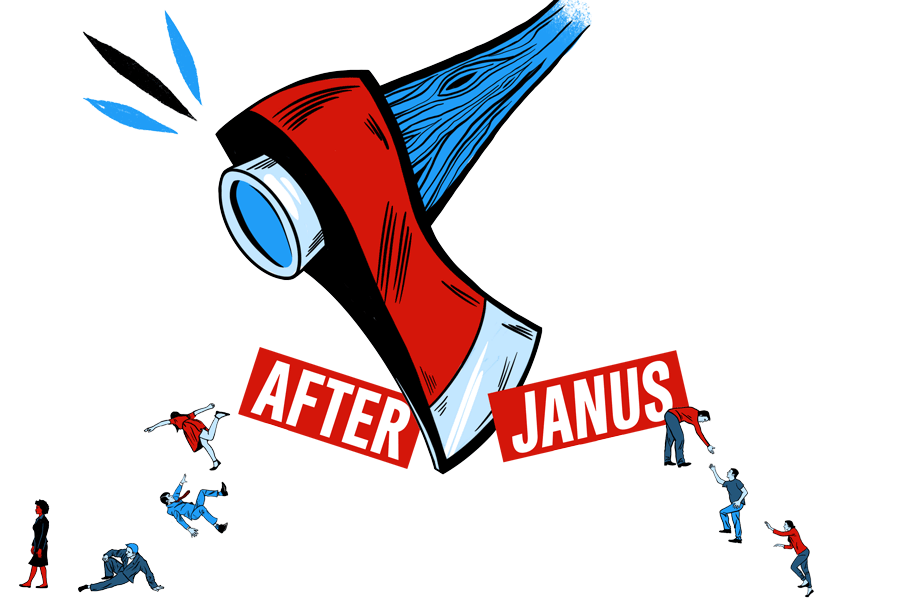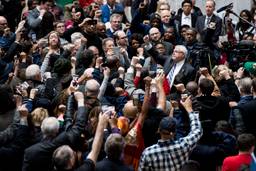Disaster Averted: How Unions Have Dodged the Blow of Janus (So Far)
Public-sector unions defied the Right’s attempt to crush them—and were transformed in the process.
Heather Gies

Months after the Supreme Court’s June 2018 Janus v. AFSCME decision, public-sector unions are not teetering on the brink of collapse, as their detractors may have hoped. The consensus is that good preparation softened the initial blow.
“Anyone writing our obituary is going to be sorely disappointed,” Lee Saunders, president of the American Federation of State, County and Municipal Employees (AFSCME), tells In These Times. “We don’t believe we are going to get hurt nearly as badly as people thought by Janus.”
U.S. labor law requires unions to represent everyone in a bargaining unit whether or not they opt to be official, dues-paying union members. Prior to Janus, most states required those who opted out to pay for that representation through “fair-share fees,” set at a percentage of dues. In one fell swoop, Janus eliminated fair-share fees for public-sector unions nationwide, allowing nonmembers to get all the benefits of the union without paying.
In These Times spoke with five U.S. public-sector unions affected by Janus: AFSCME, the American Federation of Teachers (AFT), the Service Employees International Union (SEIU), the National Education Association (NEA) and the Communications Workers of America (CWA). Before Janus, workers who only paid their fair share and did not choose to be members made up 3 percent to 9 percent of the people represented by these unions. With the ruling, revenue from public-sector fair-share fees vanished.
But Janus also poses another, deeper threat. Current dues-paying members may decide — with an assist from rightwing “opt-out” campaigns — to leave the union, knowing they can get the benefits for free.
Public-sector unions have been hard at work to re-engage members and convince them not to opt out. These initial efforts have been successful, with far lower opt-out rates than feared, some below 1 percent. The unions are benefiting from a favorable climate: Approval of labor unions is at a 15-year high, and a majority of Americans view unions positively. “I’d like to think this is backfiring on all the corporate anti-union forces that cooked this up,” says CWA Secretary-Treasurer Sara Steffens.
For now, public-sector unions’ membership rates appear to be holding steady or even growing (although most unions decline to give hard figures, saying they are still collecting data from locals). Opt-ins — the conversions of fair-share fee-payers into members — have outpaced opt-outs by as much as 5 to 1. Newly unionized workplaces have also helped offset losses.
The existential threat to membership, however, is far from over. As workforces turn over, new hires may not understand why they should join the union. “It might be a slow erosion over time,” says Chris Brooks, writer and organizer at Labor Notes. “It’s probably too early to tell how deep the impacts are going to be.”
With an eye to the long game, In These Times spoke to national and local union leaders and rank-and-file members about how they are adapting to a post-Janus world.
Defying expectations
AFSCME, AFT, SEIU, NEA and CWA tell In These Times that months, if not years, of preparing for Janus helped them dodge the bullet. CWA and AFSCME began member engagement campaigns in 2015 in anticipation of the Supreme Court banning public-sector fair-share fees through another case, Friedrichs v. California Teachers Association (only to have the death of Justice Antonin Scalia grant a reprieve). Through a program called AFSCME Strong, AFSCME prioritized personal conversations as a strategy to strengthen the union. Nearly 200,000 fair-share fee-payers joined as full members before Janus came down. AFSCME’s ratio of optins to opt-outs stands at 5 to 1.
NEA prepared for Janus by shifting from a “servicing culture” to an “organizing culture,” says Tom Israel, NEA director of state affiliate growth. The union trained staff and leaders in organizing, launched a New Ed Campaign to engage new hires and reached out to fair-share fee-payers. “Thousands of fee-payers thought they were actually full members and happily converted,” Israel says.
AFT, too, has been working to cultivate trust and a sense of belonging through one-on-one conversations. AFT President Randi Weingarten estimates that less than 1 percent of members have opted out. About a third of existing members have recommitted their membership — meaning they aren’t considering abandoning the union — and a number of locals are sitting at 100 percent membership, including Vanlue, Ohio; Yonkers, N.Y.; Springfield, Mass.; Scranton, Pa.; and more than 150 locals each in Minnesota and Illinois.
Membership in the United Federation of Teachers, which represents most of New York City’s public-school teachers, is at 99.3 percent. United Teachers Los Angeles (UTLA) has converted more than 1,200 of its 3,000 fee-payers into full members.
“We’ve made a strategic decision to intentionally and deliberately go out and talk to members,” says Georgia Flowers-Lee, a preschool special education teacher and a member of UTLA’s board of directors. In those conversations, local leaders emphasized that the union is “not just an insurance policy” against hostile actions by bosses, but a “tool for collective action,” says UTLA Field and Organizing Director Brian McNamara.
Only 56 of UTLA’s 34,000 members have dropped their membership as a result of Janus, while the number of individuals who voluntarily contribute to UTLA’s Political Action Council of Educators (PACE) fund for political advocacy has increased 62 percent. Members have also voted over the past few years to increase union dues to put the union on stronger financial footing.
For UTLA, resisting Janus is closely tied to the union’s broader fight to protect public education and secure a better learning environment. “The organizing of educators through the union is one of the only obstacles to privatizers’ efforts to take over our public schools,” says McNamara. “Janus is about undermining and attempting to bankrupt our union so that we’re not there to lead the social justice fight for public schools.” The union voted 98 percent in August 2018 to authorize a strike, set for January 10 as this issue went to press.
UTLA is following in the footsteps of the Chicago Teachers Union (CTU), which went on strike to fight cuts in 2012 after a reform caucus was voted into power. Its strategy of mass action and community engagement around public education fostered an esprit de corps that, along with internal member engagement, helped stave off Janus dropouts. Only 20 out of more than 25,000 CTU members have opted out. “The political initiative to weaken labor has been met with defiance within our ranks,” says CTU President Jesse Sharkey.
For Sharkey, the 2012 Chicago strike and the 2018 Red for Ed movement show “public education finding its voice collectively and leading by example.” He adds, “There’s no blueprint for that.”
Opt out? No thanks
In many states, public-sector unions are up against right-wing groups bombarding members with opt-out messaging at home and at work. Public-sector union members are uniquely vulnerable to such campaigns because their contact information can be obtained through public records requests.
Representatives of AFSCME and AFT say that these attempts have largely backfired, and have instead galvanized support for the union.
One of the most aggressive opt-out campaigners is the Freedom Foundation, part of the State Policy Network of corporate-backed conservative groups that helped bankroll Janus. Attempting to take advantage of what it calls “the opportunity of a lifetime” to gut unions, the Freedom Foundation has targeted public employees in Alaska, California and Oregon with mailings, email campaigns, canvassing at large work sites, door-to-door visits, and an “Opt Out Today” website disguised in union colors.
The Freedom Foundation claims it has contacted 180,000 public employees and convinced 25,000 to opt out. But Peter Starzynski, executive director of Northwest Accountability Project, a watchdog group, doubts that figure’s accuracy, noting that the Freedom Foundation’s director of labor policy told the right-wing website PJ Media that the calculations were “more art than science.”
“Contrary to the Freedom Foundation’s thinking, union members aren’t stupid,” Starzynski says. “They know the Freedom Foundation has supported every anti-worker and anti-family policy the far-right has to offer.”
One of the Freedom Foundation’s targets is SEIU Local 503 in Oregon, a 72,000-strong union whose members include home-care providers and state workers. Shamus Cooke, a social worker and one of Local 503’s chief stewards, suspects the campaigns are making a dent in Local 503’s ranks based on how “easy and compelling” they make it to opt out.
Cooke, who lost a bid to become the local’s executive director, says that the local’s leadership did not invest in educating members about Janus in advance, and conversations he’s had at different work sites have revealed a “general dissatisfaction” with the union.
But Sara Campos, an employee at the Department of Human Services in Salem, Ore., and a board member of Local 503, says most people seem to understand that it’s the union, not the Freedom Foundation, that looks out for workers. She says, “What’s been most effective is just talking to my co-workers.”
New members have outpaced dropouts 3 to 2, Campos adds. Local 503 declined to disclose the total number of dropouts.
The Pennsylvania State Education Association (PSEA), an NEA affiliate, has also faced a slew of optout campaigns targeting its 181,000 members. The Keystone Teachers Association (KEYTA), which bills itself as a “professional alternative to union membership” for teachers, has tried to recruit teachers away from the union, according to Chris Lilienthal, PSEA assistant director of communications. In lieu of the workplace power a union provides, KEYTA offers $400-a-year liability insurance.
Lilienthal says that internal communications to members have provided a “strong counterbalance” to the efforts of outside groups to lure away members. Since Janus, only about 900 PSEA members, less than 1 percent, have opted out. According to Lilienthal, although some of the dropouts will be offset through new member sign-ups, PSEA expects a net loss of membership.
One of PSEA’s locals, the Interboro Education Association (IEA) in southeastern Pennsylvania, has retained 100 percent of its 300 members. Dan McGrath, a social studies teacher and former president of IEA, chalked up the success to a “multi-pronged” effort to prepare for Janus with a focus on one-on-one conversations led by respected workplace leaders. At the end of each conversation, leaders asked members to pledge to remain in the union. “It empowered some of our members,” McGrath says, noting it also provided an opportunity for members to ask questions and raise concerns.
After Janus, one IEA member threatened to abandon the union over political disagreements when the NEA celebrated Colin Kaepernick’s Know Your Rights Camp. The camp, inspired by the Black Panthers’ 10-Point Program, teaches skills to Bay Area black and Latino youth, such as how to respond to police brutality and access higher education. Over breakfast, a trusted IEA leader discussed the benefits of union representation with the skeptical member, who ultimately decided not to abandon IEA. “By sitting down and breaking bread, they found common ground,” McGrath says.
Cutting corners?
Most unions say they did not cut staff in anticipation of lost Janus revenue, although some imposed other belt-tightening measures, such as cutting back on travel. The bet largely paid off: With membership holding steady, budgets have not been hurt as badly as feared. AFT expected an 8 percent revenue loss, but “it’s been far less,” says spokesperson Andrew Crook. NEA’s most recent fiscal year ended two months after Janus. Its annual report showed net gains, not losses, in membership and revenue despite 87,000 lost fairshare fee-payers.
SEIU did hedge against Janus by reducing staff. One SEIU local staffer, who requested anonymity so as to speak freely, was critical of this decision, arguing that resources should have been mobilized to organize in “potentially breakthrough ways” that build worker power but won’t necessarily produce immediate dividends.
Member engagement takes time, labor, know-how and a willingness to listen to members, which may be daunting to some unions. Kate Bronfenbrenner, senior lecturer and director of labor education research at Cornell University’s School of Industrial and Labor Relations, says that unions that are naturally public-sector — like education, healthcare and government work — are often better equipped for post-Janus member engagement than unions like building trades that jumped on the public-sector bandwagon because it was easier to organize than the private sector. For these unions, she says, “Putting money into offering benefits is easier than going out and doing the hard work of building a union.”
In the Midwest, five building trades locals — carpenters, laborers, electrical workers and two operating engineers unions — teamed up to pioneer a members-only benefits program to discourage dropouts. The Midwest Coalition of Labor (MCL) offers its 100,000 members — 10,000 of whom are public-sector — a special package of benefits, such as life insurance. MCL spokesperson Kim Ortiz says the coalition has been “extremely effective.” Of the 10,000 public sector members, only 40 have dropped their membership since Janus, and MCL is in the process of bringing more unions on board.
Labor Notes’ Brooks, however, sees such programs as misguided. “We have to go back to unions’ roots,” he says. “We win when we fight, not when we provide better services.”
Employers react
A report released in May by Robert Bruno, a professor at the University of Illinois at Urbana-Champaign School of Labor and Employments, and Frank Manzo, policy director of the Illinois Economic Policy Institute, projected that Janus would hurt public-sector wages by disempowering unions in bargaining. They predicted a 3.6 percent drop in wages for government workers and 5.4 percent for public school teachers (with an annual hit to the U.S. economy of between $11.7 billion and $33.4 billion).
The impacts on wages will only come to light as contracts come up for negotiation. Thus far, responses to Janus from employers have ranged from supportive to opportunistic.
In the wake of the ruling, the Cincinnati Board of Education affirmed labor rights by passing a resolution that read: “Under Ohio law, the rights of public-sector employees are unaffected by the decision in Janus.”
At the University of Illinois at Chicago, on the other hand, four of the largest on-campus unions missed thousands of dollars in dues that the university did not deduct from post-Janus paychecks in July. The university cited issues processing the payroll changes necessary to remove fair-share fee-payers. Two of the unions have filed an unfair labor practice complaint with the state.
Meanwhile, Licensed Practical Nurses (LPNs) at the University of Illinois Hospital and Clinics (UIH), who were in the middle of negotiating a new contract, witnessed a shift after Janus, when the university brought in a new negotiator and turned to hardline bargaining.
Tristan Bock-Hughes, an external organizer with the Illinois Nurses Association, accuses the university hospital of “trying to create a second-class status” for LPNs by refusing contract protections held by other campus workers. Of the 35 employees in the bargaining unit, 33 are women of color.
From the underpaid starting wage of $17.59 for LPNs, about $7 less than the Chicago standard, UIH proposed an increase of 71 cents. The low wages keep the LPNs chronically understaffed, roughly 15 spots short of a full contingent. “The unfairness is very blunt,” says Rosa Cantu, an LPN who has spent 13 years of her three-decade nursing career at UIH.
The university’s post-Janus actions brought together the four campus unions, representing nurses (including the LPNs), graduate students, faculty and clerical, maintenance and technical workers. On Nov. 15, 2018, they held a joint action at the university’s Board of Trustees meeting. About a hundred workers marched into the meeting with signs demanding fair contracts, living wages and an end to union busting. On the same day, the LPNs went on strike and were joined by their fellow unions on the picket line.
The Right smells opportunity
Janus has opened a new chapter in the decades-long fight over labor law.
On the pro-labor side, some blue states have stepped in to help unions weather Janus. New laws in New York, New Jersey, California, Maryland and Washington state ensure unions can meet with new hires. California, Washington and New Jersey also prohibit public-sector employers from urging employees to drop out of the union.
But the right-wing American Legislative Exchange Council (ALEC), which led the charge to pass anti-union “right-to-work ” laws at the state level, sees opportunities in Janus. The group has drafted laws to further curtail public-sector unions’ rights. Lead Janus plaintiff Mark Janus was a featured speaker at ALEC’s annual conference in December 2018, where, according to Governing magazine, he was hailed as a hero. Janus — who has left his job as an Illinois state employee to work for the right-wing think tank that bankrolled Janus—urged the state legislators in attendance to introduce ALEC’s model laws in their states.
ALEC’s Public Employee Rights and Authorization Act, for example, would require public employees to actively opt in as union members by signing a form “waiving [one’s] right to free speech.” Other ALEC bills would open the door to decertification of public-sector unions, ban paid “release time” for public employees to conduct union business, and chip away at collective bargaining by allowing public employees to bargain independently.
On another front, anti-union think tank the Buckeye Institute filed two lawsuits in August 2018 inspired by Janus. The suits challenge exclusive representation, unions’ right — and duty — to represent everyone in a bargaining unit once a majority has voted to unionize.
While the Right has long had its eye on exclusive representation, some in the labor movement have also come to question it in the wake of Janus. Labor experts James Gray Pope, Ed Bruno and Peter Kellman argued in a joint article for In These Times that abandoning exclusive representation for a “members-only” model would nullify the threat of increasing numbers of “free riders,” among other benefits.
The issue is controversial. AFSCME responded to Janus by enshrining its commitment to exclusive representation. Randi Weingarten says AFT is on the same page. “It’s really important for fairness that a contract applies to everyone.”
Legal possibilities for labor
Unions are also considering new legal strategies opened up by Janus. Robert Bruno thinks Janus “could be a way to look for additional legal rights.” He believes the logic of First Amendment rights in the Janus ruling could call into question the constitutionality of state laws that limit union activity, such as restrictions on strikes or on subjects of bargaining.
One member of the Midwest Coalition of Labor, the International Union of Operating Engineers (IUOE) Local 150, has begun to test these waters. In anticipation of the Janus ruling, in February 2018 the union filed suit against outgoing Illinois Gov. Bruce Rauner, chief architect of the Janus suit. Sweeney v. Rauner argues that Janus renders central provisions of Illinois labor law unconstitutional, such as unions’ duty to fairly represent workers who don’t pay dues.
Local 150 also made the unconventional decision to walk away from a small bargaining unit of 14 members, the Winnebago County Forest Preserve District, after five employees opted to leave the union after Janus. (The union used a longstanding, but rarely exercised, option under Illinois labor law called a “disinterest petition.”)
“It’s a clear message: If you don’t value our service, we’re not going to give it away for free,” says Local 150 Senior Counsel Ken Edwards. “There has to be a consequence for people not paying.”
Brooks calls moves like Local 150’s a “terrible precedent,” stressing that unions draw their strength from collective representation.
Firing up the labor movement
Bruno tells In These Times that while an immediate “mass exodus” of union members has not occurred, he still predicts that Janus will decrease unionization rates over the long term. He and Manzo estimated that Janus will eventually lower membership among government employees by 8.2 percent and among teachers by 4.8 percent.
“We are on target to see roughly the numbers we predicted,” says Bruno, who believes the full impact of Janus will not be known for three to five years.
He adds that Janus could also spark a labor surge. “It might generate a higher level of union activism,” he says. “If that happens, what they’ve intended to do here may backfire.”
If Janus has a silver lining, it is that unions have been challenged to rethink and transform their organizational cultures. Responding to Janus means not only exposing the intentions of the union busters who organized the lawsuit, but also recuperating the value of union membership within the union. SEIU Healthcare Illinois & Indiana Vice President Alex Han says Janus has sparked a “resurging activist core and leadership base.”
He adds, “The saying that the boss is the best organizer is true.”
Cedric de Leon, sociology professor and director of the Labor Center at the University of Massachusetts Amherst, is optimistic. “Unions existed before dues collection, and they were militant and improved the lives of workers,” he says. “What the labor movement needs now more than ever after Janus is a rediscovery and recuperation of the first principle that organizing is the whole damn ball game.”
Aside from forcing unions back to basics, he suggests Janus could also be a wake-up call. “People should care about Janus because it shows there is class war happening in this country and it is the employer that is waging a one-sided war against American workers,” he says. “The question then becomes, what are we going to do about it?”








